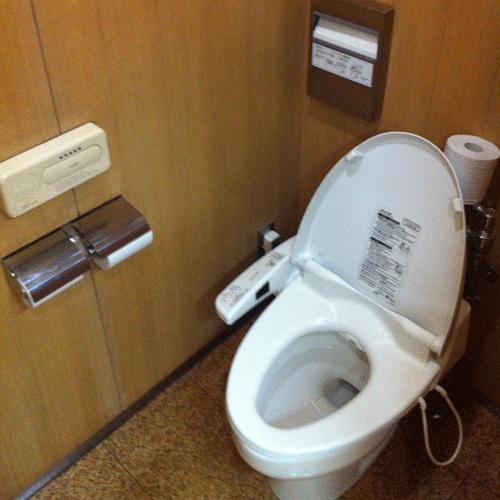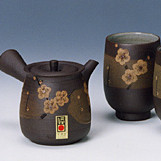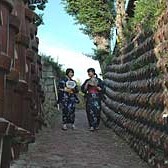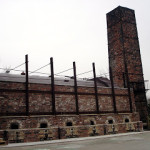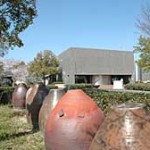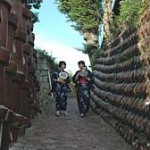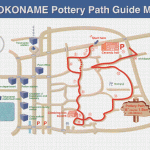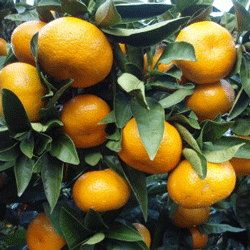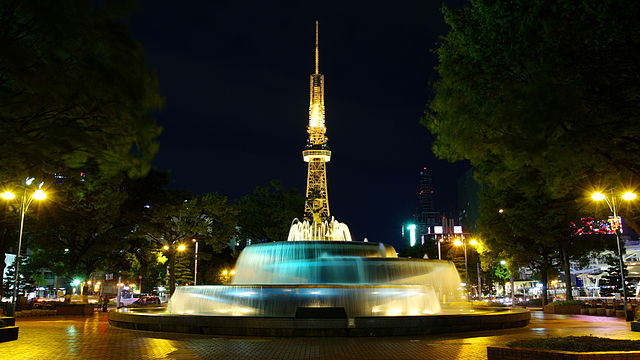Dec 20, 2012
10 Things to Know about Using Japanese Toilets
- Some toilets have heated seats, which make winter usage much more pleasant.
- Don’t mess with the buttons unless you are sitting and know what they are for!
- “Otohime” or sound princess can be used to cover the sound of bodily functions by broadcasting the sound of a toilet flushing through a small, push button speaker system.
- Some public toilets have automated disposable/clean toilet seat paper covers. Often you will find chemical cleaning sprays as well.
- Toilet slippers are meant for just the toilet, as historically in Japan, toilets were located outside of the house. Do not wear them out of the bathroom!
- Many home toilets have a wash basin set on top of the toilet water tank.
- Public toilets may not have towels, paper towels or dryers to dry your hands, BYOH (Bring your own hankerchief.)
- “Washiki” is the Japanese term used for traditional squat toilets.
- Broken public toilets in Japan are not common, but public toilets without paper ARE common! BYOTP!
- By JSA standards, Japanese toilet paper must dissolve within 100 seconds when placed in water. Beware of clogging with foreign bought toilet paper!
More on Japanese Toilets
Japan’s High-tech Toilet Culture
How to Use a Squat Toilet With Pictures!
How to use a Japanese toilet. This one has pictures of the “buttons” you should know.

Nov 12, 2012
Ceramics Shopping at the Cera Mall
The “ Cera Mall” is a wholesale pottery shopping park in Tokoname City, on the Chita Peninsula.
Cera Mall” is a wholesale pottery shopping park in Tokoname City, on the Chita Peninsula.
The area is famous for pottery, and you will find every local variety represented at the Cera Mall; which is the largest outlet in both scale and variety on the Chita Peninsula for ceramics. You will also find a few small cafes, a nice park for kids, and lots of free parking available for you to use while you shop till you drop for “tokoname yaki.”
What is “tokoname yaki?” Tokoname Pottery, or tokoname-yaki ware has been produced in the city of Tokoname, Aichi Prefecture for over 1,000 years. Originally, items such as vases were fired without glaze. Later, Tokoname ware became famous for the production of earthenware pipes, and is now widely known for pottery using red clay. Tokoname ware was designated an official Japanese traditional craft in 1976.
CERA MALL – Tokoname Pottery Wholesale Park
99 Kamisunahara, Kanayama-Aza Tokoname City, Aichi
TEL: 0569-43-7125
The ceramics on sale range from top-of-the-range handcrafted masterpieces, through to 3 for 100 yen type pricing for slightly defected or older items. The items available include cups, sauces, and plates right through to big items such as umbrella stands, large pots for outside gardening and even decorations for Christmas and New Years (obviously depending on the season).
I am not a great shopper at any time of the year, but this is one of the places I really enjoy wandering around. I especially enjoy the bargains available on a lot of rice bowls, plates (small and large) and it is a common place to go to pick up an omiyage to take back to New Zealand for my family. I have also introduced newly wed couples to Cera Mall on many occasions, as it really is a great place to fit out your kitchen if you don’t have one yet….. cheaply, but nicely!
If you have a little time on your hands, this is a perfect place to visit before or after the beach in Utsumi, or some of the fish markets in the south of Chita Peninsula. Look out for the Tokoname Pottery Path also, if you are a real ceramics fan!
Happy shopping!
Nov 12, 2012
The Tokoname Pottery Path
The Tokoname Pottery Path, or “Yakimono Sanpomichi” offers views of old traditional houses, workshops, buildings, implements of production, and pottery that typify the character of Tokoname’s unique atmosphere. This atmosphere stems from Tokoname’s storied history. It was already well-known as a pottery town at the end of the 12th century. Tokoname is one six traditional pottery towns in Japan; others include Bizen, Shigaraki, Tamba, Seto and Echizen. They are collectively known as “The Six Ancient Kilns of Japan.”
The path begins about 5 minutes walk on the east side of Meitetsu Tokoname Station. From there you can enjoy the promenade beginning at the Ceramic Hall. The total walking course is about 1.5 km -0.93miles, and takes roughly 60 minutes. The meandering path winds through a labyrinth of roads through unique Tokoname. You can visit many of the workshops and studios, and see a wide variety of pottery; from the centuries old, to the brand new. From cheap, to exorbitant. The earthen pipes and shochu pots are especially famous. Many historic and new means of pottery production, such as kilns and brick chimneys, line the path as well.
Volunteer guides are available to gide you through the popular Pottery Path in both Japanese and English, though reservations are required. To reserve please call – 0569-34-8888.
While you are there, why not check out the Cera Mall; a Tokoname Pottery Wholesale Park. It is a comprehensive pottery-ceramics shopping zone, which is the largest in scale and variety on Chita Peninsula for ceramics.
- Tokoname Pottery Path Map
Oct 24, 2012
Picking Mikan Oranges in Nagoya
 Late autumn and winter in Japan is orange season, and people go nuts for them. When I first came to Japan they had this amazing orange chu-hai available that has basically ruined orange chu-hai for me forever. It was like an orange crush that made you more handsome and charming! Nothing has matched it since, with the possible exception of real oranges.
Late autumn and winter in Japan is orange season, and people go nuts for them. When I first came to Japan they had this amazing orange chu-hai available that has basically ruined orange chu-hai for me forever. It was like an orange crush that made you more handsome and charming! Nothing has matched it since, with the possible exception of real oranges.
In winter and late fall you can buy bags of what we in the west call Satsuma Oranges, the most rebellious of all oranges. Satsuma Oranges, called mikan here in Japan were first grown in modern Satsuma prefecture. They are small, seedless oranges that peel easily and are incredibly sweet.
The harvest season in Aichi and the surrounding area begins in October and run through to December. But with October still warm, and December getting cold; November is the time to go out and pick them yourself. Orange picking is “experience” tourism with tasty results; why not take your family out and try this fun and healthy activity this month?
You can generally pick and eat as many as you like, and are given a pre-packaged bag to take home with you when you are done, and the hours vary by location during the season. The actual mikan picking generally does not require a reservation, but some of these farms also offer BBQ sets along with the picking experience and for that you will need to make a reservation. For more details about the farms see their website, or the original article on the NIC website.
Mt Togoku Fruits Park in Nagoya
- 2110 Togoku, Kamishidami, Moriyama-ku, Nagoya, Aichi Prefecture 463-0001, Japan
- www.fruitpark.org (Japanese) | 052-736-3344
Gamagori Orange Park 蒲郡オレンジパーク Orange Orchard
- Adults 1115 Yen, children 1050 Yen, pre-schoolers 525 Yen.
- Gamagori City, Seida-cho, Ogurimi1-93 蒲郡市清田町小栗見1-93
- Website | 0533-68-2321
Joyful Farm U-no-ike ジョイフルファーム鵜の池 Orange Orchard
- Adults 1100 Yen, children 650 Yen, pre-schoolers 450 Yen.
- Chita Gun, Mihama-cho, Kaminoma aza-nakashinden 10 知多郡美浜町大字上野間字中新田10
- Website | 0569-87-6069
- Free pick up service from (Meitetsu) Kaminoma上野間 Station if call ahead in advance (in Japanese!)
Utsumi Fruits Mura (Tanakaen) 内海フルーツ村 田中農園 Orange Orchard
- Adults 1100 Yen, children 650 Yen, pre-schoolers 450 Yen
- Minamichita-cho, Utsumi, Okusuzugatani 70南知多町内海字奥鈴ケ谷70
- Website |0569-62-2430
- Free pick up service from (Meitetsu) Utsumi Station if call ahead in advance (in Japanese!)
Suzugatanien 鈴ケ谷園 Orange Orchard
- Adults 1100 Yen, children 650 Yen, pre-schoolers 450 Yen. You can also download and print out a discount coupon from the Minami Chita Tourist Association website (http://bit.ly/suzumikan). It is in Japanese, but it offers a lot of information as well!
- Minamichita-cho, Oaza-utsumi, Aza-oku-suzugatani 70-18 南知多町大字内海字奥鈴ケ谷70−18
- Website | 0569-62-1497
- Free pick up service from (Meitetsu) Utsumi Station if you call ahead in advance (in Japanese!)
Sep 29, 2012
100 Yen Stores in Nagoya – Not “cheap,” CHEAP!
 Back home you might not shop at what we in the US refer to as “dollar stores,” or stores where everything is priced at 1 US dollar, because they are generally associated with poor quality goods, but this is not the case in Japan. 100 yen stores offer a wide variety of goods to solve little problems you never realized you had, and often the items on offer are of very similar quality to those available in much more expensive grocery or hardware stores.
Back home you might not shop at what we in the US refer to as “dollar stores,” or stores where everything is priced at 1 US dollar, because they are generally associated with poor quality goods, but this is not the case in Japan. 100 yen stores offer a wide variety of goods to solve little problems you never realized you had, and often the items on offer are of very similar quality to those available in much more expensive grocery or hardware stores.
These shops specialize in purchasing huge quantities to get big discounts on a wide variety of items such as: table and kitchenware, tools, garden items, stationary, household and leisure goods from China and other countries with low production and labor costs that enable them to price them at what are sometimes below actual market value.
You can find 100 yen shops all over Nagoya in sizes that range from multi-story standalone buildings, to small kiosk style corners in malls and supermarkets. One of my favorites is the Daiso on the 7th floor of the Skyle building in Sakae; they seem to have everything!
The Daiso
Daiso is a most people’s favorite, as they tend to be much bigger than other shops and hence offer a wider variety of goods. website (Japanese)
Seria
While not as big as Daiso, these are still pretty big and offer a wide varied of goods. website (Japanese)
Lawson 100
These are kind of the low end of the scale. They offer significantly fewer small items, instead they offer cheap foods. You can get some good seasonings and pre-packaged mixes there cheaply. website (Japanese)
A partial list of 100 yen shops in and around Nagoya:
Meito-ku
DAISO Meito-jiami
7-151 Wakaba-dai, Meito-ku, Nagoya
℡ 052-760-8901
Chikusa-ku
DAISO Nagoya-Imaike
3-12-12 Imaike, Chikusa-ku, Nagoya
℡ 052-744-1202
Showa-ku
Seria AEON Yagoto
2-1 Ishizaka, Hirojicho, Showa-ku, Nagoya
℡ 052-833-5123
Mizuho-ku
DAISO Pare Marche-Horita
Pare MarcheHorita 2F 28-26 Shinkaicho, Mizuho-ku, Nagoya
℡ 052-884-3360
Tenpaku-ku
DAISO Hirabari-minami
5-1405 Hara, Tenpaku-ku, Nagoya
℡ 052-800-6775
Naka-ku
DAISO Nagoya-sakae-skyle
3-4-5 Sakae, Naka-ku, Nagoya
℡ 052-259-0160
Google Maps
Toyota City
DAISO Toyota-248
1-11 Motomiyacho, Toyota-shi
℡ 0565-36-6080
Sep 14, 2012
Flea and Farmer’s Markets in Nagoya
Flea Market at Osu Kannon Temple
 Osu Kannon Temple was moved to its current location by the very late and very great Tokugawa Ieyasu in 1612. The main temple on the site today was reconstructed in 1970.
Osu Kannon Temple was moved to its current location by the very late and very great Tokugawa Ieyasu in 1612. The main temple on the site today was reconstructed in 1970.
The Flea Market at Osu Kannon is held rain or shine on the 18th and 28th of every month like clockwork. If you are in the area this market offers around 60 stalls on average, and is fun to browse due to the eclectic nature of the wares on offer. You never know what you might find in the mishmash of genuine antiques and complete junk, fine art and kitsch, the truly useful and the totally frivolous. There is one stall that specializes in used kimono that I have heard mentioned a few times, so if you are in the market for one it might be worth a visit.
Most dealers are seasoned veterans, so real deals can be hard to find, but a good eye is often rewarded! This market is popular with international visitors looking to score an out-of-the-ordinary souvenir or two, and if you fail, there is always the nearby Osu Shopping Arcade. I personally make a trip out to Osu 3 times a month or so just to drop in. It has a really cool atmosphere. The karage, roasted chicken, and pizza place are all highly recommended.
Flea Market at Osu Kannon Temple
- Held on the 18th and 28th of every month, rain or shine.
- Osu Kannon (google)
Oasis 21 Farmers Organic Morning Market
If you are after a nice organic potato, carrot, cabbage, or other fruits and vegetables this might be your best option. Every Saturday morning you can find about 20 tables / stalls setup inside of Oasis 21, in front of the Starbucks that are staffed by farmers and their family members. On the rare occasion you will happen upon a real find here; I saw kale once, and that stuff is impossible to find in Nagoya. Please note I said ONCE! They always offer the standard variety of whatever is in season though, and they are super friendly people!
- Oasis 21 Farmers Organic Morning Market
- Held every Saturday from 8:30 – 11:30.
- Oasis 21 in Sakae
Nittai-Ji Temple Farmer’s Market
Nittai-Ji Temple was constructed in 1904 to hold the ashes of the Gauthama Buddha, a gift to Japan from King Chulalongkorn of Thailand. It was named the “Japan-Thai Temple”, to celebrate friendly relations between the two nations. The temple features the 15 meter Gandala-style Taian Pagoda, which houses the relics Japan received.
Nittai-Ji Temple hosts a farmer’s market on the 21st day of every month. While not an organic market per se, it is larger than the weekly market held at Oasis 21 and you can get very good deals on a larger variety of seasonal vegetables- especially if you are willing to by larger volumes. I once got a bag of peanuts there that came very close to being enough peanuts for me…close, but no cigar. You can NEVER have enough peanuts in my opinion.
Nittai-Ji Temple Farmer’s Market
- 21st day of every month from 8:30 – 11:30
- Nittai-Ji Temple, near Kakuozan Station (google)
Kōshō-Ji Temple Farmer’s Market
Kōshō-Ji Temple was established by Nagoya’s beloved Tokugawa clan in the 17th century. The temple and grounds, including the graveyard, are situated in the woodlands of Yagoto Hill. The temple complex consists of wooden buildings including a five-story pagoda completed in 1808. The annual “1,000-Lantern Festival” takes place here, and is supposed to be notable, but I could find no specific information about it; anyone been? Kōshō-Ji Temple also holds a monthly farmer’s market on the 21st of every month that is very similar to the one held at Nittai-Ji.
Kōshō-Ji Temple Farmer’s Market
- 21st day of every month from 8:30 – 11:30
- Kōshō-Ji Temple, near Yagoto Station (google)
Satoyama Market at Shinrin Park Golf Course in Owari Asahi
Shinrin Park Golf Course in Owari Asahi hosts a farmer’s market where local produce is sold in the car park. Satoyama market is held periodically at the main gate at Forest Park Square. Producers from the local area provide environmentally friendly, natural fruits and vegetables for purchase on market days. Enjoy safe and secure agricultural products as well as Fresh fruit and vegetables, flowers, plants, pottery and other local produce.
- Park information – www.shinrinkoen.com/satoyama/ichiba.html
- Schedule of Market – www.aichishinrin.jp/news/ichiba.html
- The phone number for your car navigation is 0561-53-3993 and here is a map
- 5182-1 Arai Owariasahi, Aichi Prefecture 488-0081, Japan
Mammoth Flea Market
Featuring over 3500 booths and 60,000 attendees, the Mammoth Flea Market is largest flea market in Japan. It fills the entire Port Messe building with all kinds of bargains and bargain hunters. This event is held annually, as we mentioned at Port Messe, in late April.
- Annually in Spring
- Port Messe Nagoya (ポートメッセなごや), near Kinjo-futo Station on the Aonami Line.
Kikuko’s Website: Secondhand Kimono shop/Reuse kimono
Nagoya Flea Markets
Jul 09, 2012
Thai Food in Nagoya

Quite a few restaurants in the Nagoya area serve up authentic Thai food, or ingredients. Thai food gets more popular every year in Japan, and you can bet there are more options than these out there, but none as popular with the foreign communities of Nagoya. Here we have three options for your perusal: 2 restaurants and a grocery store.
Sukhontha (Restaurant)
- Amuse Nishiki 1F , 3-18-13 Nishiki Naka Ward, Nagoya, Aichi Prefecture 450-0002
- 052-957-7889
- www.sukhontha.jp
- Map Location
Another nice place to eat is Siam Garden, which is near the Hilton in Fushimi. The building is the coolest part about that location. I heard once that it used to be a Thai consulate many years ago, but it really looks like an old bank.
Siam Garden (Restaurant)
- 1-15-17 Nishiki Naka Ward, Nagoya, Aichi Prefecture 460-0003
- 052-222-8600
- www.siamgarden.jp
- Map Location
If a night out on the town is not what you seek, but the means to cook Thai food yourself then you will want to know about the small Thai grocery near Sakae. Chaiyaphum is very small, but it is the only place I have found where you can get Thai basil reliably. It’s a bit of a walk, but its worth it if you are in the market for Thai ingredients. The owner is Thai, and they do not speak any English, but they are very nice so stop in anyway!
Chaiyaphum (Thai Grocery Store)
- 5-21-21 Sakae, Naka Ku, Nagoya, Aichi Prefecture 460-0008
- 052-251-1728
- (No Website)
- Map Location

Jun 09, 2012
The Pig in Osu – Yabaton Kushi Katsu
If you have spent any time in Nagoya at all, you’ll recognize the Yabaton pig. Yabaton is a staple food in the miso capitol of the world; it’s the home of the Miso Katsu renowned across the globe. Sure, serving the most famous Miso Katsu on the planet doesn’t place Nagoya or Yabaton on many people’s bucket lists, but if you love miso and fatty pork cutlets, there’s no need to bother making the list; Yabaton is heaven on earth.

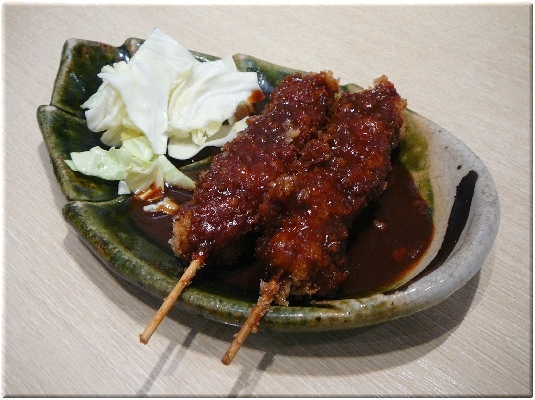
The Dragons bailed out of that classic post-war diamond to their current dismal Nagoya Dome in 1997, but Yabaton didn’t go with them, so you won’t be eating Kushi Katsu at a Dragon’s game anymore (unless you smuggle in take-out). Too bad about the Dragon’s lackluster new home, but “Yabaton” had become a household word in Nagoya, and famous throughout Japan. People throughout the nation started to pilgrimage to the little Osu Kannon shop decorated in Chunichi Dragons regalia.
The other day my wife and I set out to eat at the original Yabaton. It’s not the crowded storefront on Otsu Dori. The old shop was behind it, on one of the narrow Osu pathways marked as a two-way street. Although my wife grew up here, she hasn’t lived in Nagoya regularly for ten years, but still somehow remembered just where the old place was. As we walked she told me about the cramped two story building with shared tables, diner style waitress, and a line of cooks behind the bar. When we arrived, famished, at the spot that her motor memory led us, the building she described so vividly… the classic restaurant… the Nagoya landmark… was gone. Japanese history once again meets the wrecking ball.

May 22, 2012
Hisayaodori Park in the Heart of Nagoya

Sakae’s Hisayaodori Park is a very nice urban park that features events on weekends; if the weather is good, nearly every weekend. The park also contains the Nagoya TV Tower. The 180-meter tower was the first built in Japan back in 1954. Since then, Nagoya has become quite fond of it, and the TV Tower is often mentioned as a symbol of Nagoya. When the weather is nice you can find families and couples taking pictures in front of it, and at night when the tower is illuminated it dominates the skyline and can be seen from all over Sakae.
The part of the Park that is used for large events is near Los Angeles Plaza, near Lachic and Parco. This space is where the Thai and Belgium Beer Festivals are held each year!
Hisayaodori Park
460-0002 Aichi ken, Nagoya shi, Naka ku, Marunouchi 3 (google map)

More Info
http://kikuko-nagoya.com/html-map/map-parks-sakae.html
By 名古屋太郎 [CC BY-SA 3.0 or GFDL], from Wikimedia Commons
Mar 12, 2012
German Food in Nagoya
 There are not many places in Nagoya to eat German food, but you can find some of the ingredients. By which I mean I sometimes see sauerkraut in the supermarket, and there is never a shortage of potatoes around. I am told there is more to German food than the kraut, brats, and potatoes, but I seem to go back to what I know. I digress…
There are not many places in Nagoya to eat German food, but you can find some of the ingredients. By which I mean I sometimes see sauerkraut in the supermarket, and there is never a shortage of potatoes around. I am told there is more to German food than the kraut, brats, and potatoes, but I seem to go back to what I know. I digress…
Zurdeele German Restaurant
The first spot is near Mizuho Undojo Nishi. Zurdeele, as pictured above, is a bit fancy, serving superb foods prepared by a chef who trained in Germany for 5 years. The exterior is stately brick house surrounded by a cozy garden. After entering you walk over a satiny floor to the main dining room, to which the restaurant’s name ‘Zur Deele’ alludes. The cozy garden and spacious lawn is truly relaxing. The staff recommends the homemade cured ham and sausage, but all selections use the best seasonal ingredients. Don’t for get the stock of German wine!
Doitsu-Un German Restaurant
Though I know much less about it, our next offering was recommended by a German friend of mine, and described as “the most authentic in Nagoya.” Doitsu-un, while actually in Ichinomiya City, that is only about 20 minutes on JR outside of Nagoya so it might be worth a jaunt out for a taste test. It is a bit pricey compared to a “normal” restaurant, about JPY 2500 per person is to be expected, but you get what you pay for.
Asakuma Doitsu Kan German Restaurant
Next we have Asakuma Doitsu-kan, in Fujigaoka. It appears to be a part of a chain, but it was recommended; though only so far as to say it was “not bad.” If you are in the neighborhood, it might be worth a taste.
Alsace German Restaurant/Deli
Finally, if you are in the market for some decent German food to work with at home you are going to need some meats. Though I would normally recommend any meat you purchase be from the Meat Guy, this is an exception. Alsace is a great spot near the Mio Kaguyama Shopping Center in Nisshin. It is actually a deli specializing German Style meat, and the pictures look great! If you make a trip there, why not let me know how it was?
